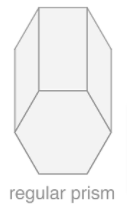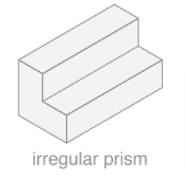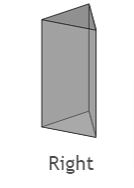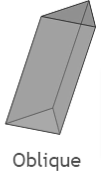Prism
A prism is a polyhedron having five sides and a triangular cross-section. There are two identical parallel triangles opposite each other in a prism. Three rectangular surfaces are also inclined to each other, in addition to the triangles. Prisms are translucent solids that are used to refract light. The refracting surfaces are the two sloped rectangular surfaces through which light flows. The refracting edge of the prism is the angle generated between these two refracting surfaces. The major section of the prism is the part of the prism that is perpendicular to the refracting edge. The prism’s base is the third rectangular surface at the bottom.
A prism is a transparent, three-dimensional object with two flat polished surfaces that are inclined at an acute angle to one another. Light reflects off of these surfaces.
Prism Properties
- The top and bottom are congruent and parallel.
- Except for the base and top, each face is a parallelogram. A Lateral face is the name given to these types of faces.
- Each lateral face has one edge in common with both the base and the top.
- The common edge of two adjacent side faces is the prism’s height.
Types of Prism
Prisms are divided into several categories, as listed below:
1. On the basis of type of polygon
- Regular Prism: It’s called a Regular Prism if the prism’s base is a regular polygon.
- Irregular Prism: Irregular Prism refers to a prism with an irregular polygon as its foundation.
2. On the basis of the alignment of bases
- Right Prism: The side faces of a right prism are perpendicular to the bases of the prism. The side faces are rectangular in this case.
- Oblique Prism: The side faces of this type are not perpendicular to the bases and have the shape of a parallelogram rather than a rectangle.
3. On the basis of the shape of bases
- Triangular Prism: The bottoms of these prisms are triangular.
- Rectangular Prism: Their bases are rectangular.
- Square Prism: Their bases are square.
- Pentagonal Prism: Their bases are shaped like a pentagon.
- Hexagonal Prism: Their bases are hexagonal.
- Trapezoidal Prism: The form of their bases is trapezoidal.
Refraction through Prism
When light goes from one medium to another, it bends. Refraction is the name for this occurrence.
Violet, Indigo, Blue, Green, Yellow, Orange and Red are the seven colours that make up white light. The difference in the refractive index of the two mediums causes light to bend whenever it enters a prism. Depending on their wavelengths, the various constituents of white light diverge at different angles.
Since violet has the shortest wavelength, it has the most deviation, while red has the longest wavelength and has the least departure. The prism refracts seven colours of light at different angles in this fashion.
Dispersion is the term for the separation of white light into its constituent colours.
Prism Formula
The following are some basic definitions and formulas for the concept:
- Incident Ray: Incident Ray is the ray that falls on the surface dividing two dissimilar mediums.
- Refracted Ray: Refracted Ray is the ray that enters the second medium with a change in direction.
- Angle of Incidence: The angle of incidence is the angle created by the incident beam and the normal. It is represented by the letter i.
- Angle of Refraction: The angle of refraction is the angle created by the refracted ray and the normal. The letter r stands for it.
- Angle of Prism: Prism Angle is the angle created between the two lateral sides of a prism. It is symbolised by the letter A.
- Angle of Deviation: Angle of Deviation is the angle formed by extending the incident ray forward and the emerging ray backwards. It is denoted by the symbol .
The prism formula is as follows in general:
Surface Area of a Prism = 2 × Base Area + Lateral Surface Area
Volume of a Prism = Base Area × Height
Derivation of the Prism Formula
According to Snell’s law, we know that,
=sin isin r
δ = i1 – r 1+ i 2– r2
δ = i1 + i 2-( r1+ r2) ….(i)
∠ALO + ∠AMO = 2rt∠s
∠LAM + ∠LOM = 2rt∠s….(ii) (sum of 4 angles of a quadrilateral = 4 rt∠s)
r1 + ∠r2 + ∠LOM = 2rt∠s……(iii)
∠LAM = ∠r 1 + ∠r2 ….(comparing eq(ii) and eq(iii))
A = ∠r1 + ∠r2
Substituting the value of A in eq(i)
δ =i1 + i 2 – A
i1 + i 2 = A + δ
i1 = ∠ i 2
r1 = ∠r2 = ∠r
∠ALM = ∠LMA = 90° – ∠r
Thus, AL = LM and LM ∕∕ BC
∠A = ∠r1 + ∠r2
A = 2r….(Since r1 = ∠r2 = ∠r)
r = A/2
i1 + i 2 = A + δ
i1 + i 2 = A + δm
2i1 = A + m
i1 = A + m/2
According to Snell’s Law,
μ = sini/sinr
∴ = {sin (A+ m)/2} / (sin A/2)
Conclusion
A prism is a clear, polished flat optical element that reflects light, according to physics. These can be created out of any transparent material with the appropriate wavelengths. Glass, fluorite and plastic are the most regularly utilised materials.
A prism is a polyhedron with two polygonal bases that are parallel to each other. The prism is a transparent optical element that refracts light and has flat polished surfaces in optics. The two polygonal bases are joined by lateral sides, which are generally rectangles. In rare circumstances, it could be a parallelogram. The prism principle can be applied to both mathematics and science.
To break the light into its spectral hues, dispersive prisms are used. Prisms can also be used to split light into its constituents using light polarisation or to reflect light.
 Profile
Profile Settings
Settings Refer your friends
Refer your friends Sign out
Sign out










